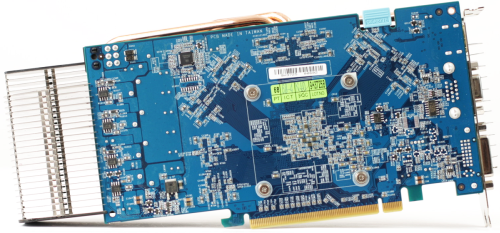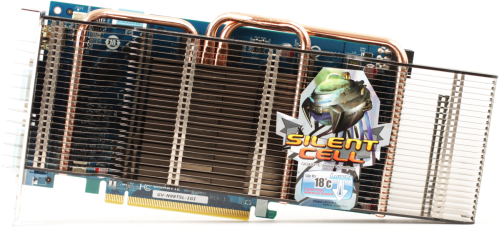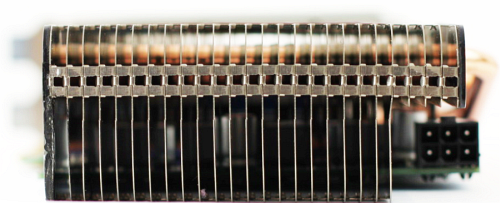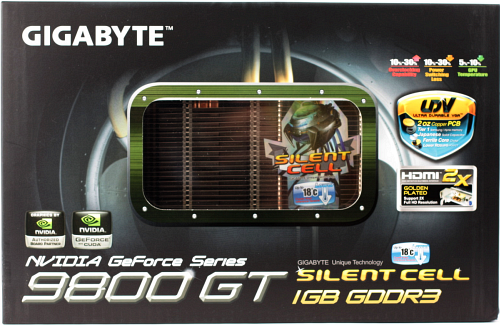

Review: When power and silence collide
Today we bring you Gigabyte’s 9800 GT Silent Cell, a unique graphics card which brings passive cooling to Nvidia’s 9800GT graphics chip. Of course, passively cooled cards are generally more basic cards and are not made with ultimate performance in mind, that task is rather left to the actively-cooled versions, but these cards have an ace up their sleeve - the golden silence. Gigabyte is of course not the first company to strap the 9800 GT with passive cooling, but are first to do so with Silent Cell cooling.
Silent Cell cooling uses multi-heatpipe technology with ultra-thin cooling fins which greatly help with heat dissipation. Gigabyte claims that thanks to the Ultra Durable ower components and Silent Cell cooling on their card, it will run more stable and up to 18°C cooler than the reference card, which as you know comes with air cooling. The picture below shows the GV-NV98TSL-1GI in all its glory (you can view pictures in higher res if you’d like, courtesy of our own Eliot Kucharik, just click on the pics).
The passive cooling solution is pretty big, even bigger than the card’s PCB. The total surface of the aluminum fins is pretty impressive, but there was simply no other way as the cooling has to be flawless on passive cards. The card is dual-slot width, allowing the aluminum fins to stretch all the way to the I/O panel, where they’ll peek out of your computer.
The three copper heatpipes are responsible for quick temperature transfer from the core to the cooling fins. The following photo clearly shows that designing while designing Silent Cell cooling , Gigabyte’s team made sure to use every single inch of free space around the card, in order to maximize dissipation surface of the cooler. You can clearly see the cooling that stretches over the entire length of the card’s PCB, ending with the PCI-Express power connector. Note that Geforce 9800 GT requires one 6-pin connector, and by thinning out the cooler above the PCI-E connector, Gigabyte made sure that plugging the card’s power in isn’t a cumbersome task.
It’s very important to note that the card’s performance will greatly depend on your rig’s airflow, as a decent airflow is a prerequisite for any passive cooling, graphics or other.
The photo above shows the copper pipes starting their journey from within the large copper base. The copper base covers the GPU and three of eight memory modules. Gigabyte didn’t chose to apply cooling to all the memory modules, as the memory runs at 900MHz despite being rated at 1GHz, which leaves space for overclocking. The Silent Cell’s large copper base is one of the main reasons behind its cooling efficiency.
The back of the card is pretty uninteresting, but it paints a picture about the size of Silent Cell cooling. The GV-N98TSL-1GI, as the name suggests comes with 1GB of GDDR3 memory and all the memory modules are placed on the GPU side of the PCB. The memory on this card is Samsung K4J10324QD-HJ1A.

In case SLI is your weapon of choice, Gigabyte’s card can easily be chained up with another 9800GT card. The SLI connector kept its standard place, and Gigabyte used a protective cap, similar to the ones on the video outs.
The GV-N98TSL-1GI comes with a dual-link DVI connector, VGA connector and a gold plated HDMI connector. In order to get sound and video all via one HDMI cable, you’ll need to use the SPDIF cable, something owners of Nvidia cards are pretty familiar with. Those who are not can refer to a special manual Gigabyte made especially for their Silent Cell graphics card.
The following photo shows the view from the other side of the graphics card, where you can see the freed up space for easier access to the power connector.
The GV-N98TSL-1GI’s clocks were left unchanged from the reference 9800GT values – 600MHz GPU, 900MHz memory and 1500MHz shaders. The reference clocks are a wise thing to do, as some users might not heed the “mind the airflow” warning and if the card had been overclocked it would’ve posed a serious problem. The card ran stable throughout our testing, and although the temperatures have indeed been lower than on the air-cooled 9800GT cards, turning off the case fans resulted in a steep temperature climb. You can find out more about this card’s thermals later on.

Although GPU-Z reports the GV-N98TSL-1GI to come with a 65nm graphics core, we took the cooler off and found out this is indeed the new 55nm G92 GPU (G92-283-B1) core which is more efficient and runs much cooler.
The 9800GT Silent Cell came in a pretty but durable box. You can see the card through the plastic window on the front and find out a couple of important info, such as Ultra Durable VGA components. In case one DVI connector isn’t enough, Gigabyte ships a HDMI-to-DVI converter, which is a great touch as it’s a rare gift with graphics cards that come with default HDMI out.





